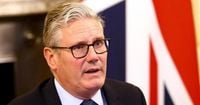Keir Starmer’s government has been thrown into a whirlwind of change after the dramatic resignation of Angela Rayner last week, triggering a cabinet reshuffle far more sweeping than most Westminster watchers anticipated. By the end of the first full week of September 2025, half of the cabinet had either changed jobs or left government entirely—a shake-up that has sent ripples through the Labour Party and the wider political landscape.
The catalyst for this turmoil was a standards report that found Rayner had breached the ministerial code over her tax arrangements, leading to her resignation on Friday, September 5. According to Institute for Government, this single event set off a chain reaction, resulting in 12 of 27 attending cabinet members moving jobs, three leaving the cabinet, and two departing government altogether. The scale of the reshuffle was in stark contrast to earlier briefings from No.10, which had suggested only minor adjustments in the lower ministerial ranks.
Prime Minister Keir Starmer wasted no time in reasserting control, moving advisers and creating a new role—chief secretary to the prime minister—filled by Darren Jones. But as the week wore on, the changes snowballed. Starmer’s official spokesman described the new team as a “government of patriots—determined to deliver for working people. That’s who we fight for.” The prime minister’s message was clear: the focus for this reshaped cabinet is delivery and growth, marking what he called the “second phase of government,” Daily Mail reported.
Yet, this attempt at a reset comes as Starmer faces mounting challenges. His personal ratings have slipped to a new net low of minus 44, according to a More in Common poll cited by Daily Mail. A summer dominated by public anger over immigration and a string of policy missteps, including a failed attempt to curb the spiraling benefits bill, have left the administration reeling.
Among the most high-profile moves, David Lammy was appointed as the new Deputy Prime Minister, stepping into Rayner’s shoes. Yvette Cooper, previously Home Secretary, has taken over as Foreign Secretary, while Shabana Mahmood was handed the crucial Home Secretary brief. Mahmood wasted no time in pledging to “do whatever it takes to get a grip on Channel boats,” a nod to the ongoing controversy over small boat crossings in the Channel, as Daily Mail highlighted.
Other notable shifts included Liz Kendall’s move from Work and Pensions Secretary to the Science Department, following internal Labour opposition to proposed benefit cuts. Pat McFadden, previously a key figure in driving Labour’s “mission-led” approach, was tasked with finding further welfare savings—an issue seen as critical to Chancellor Rachel Reeves’ efforts to balance the government’s books.
The reshuffle did more than just move familiar faces around: it ushered in a new generation of Labour MPs. After the 2024 general election, a staggering 231 of Labour’s 411 MPs were new to parliament. Initially, only eight of 89 ministers in the Commons were from this 2024 intake. Now, that number has jumped to 32 out of 92, making the newcomers the largest group in government, according to Institute for Government. Many of these fresh faces have spent their first year learning the ropes on select committees or as parliamentary private secretaries, and now find themselves at the heart of government.
Starmer’s approach to party discipline was also on display. None of the 126 Labour MPs who threatened rebellion over the welfare bill earlier this year received ministerial appointments in the reshuffle, a clear signal that loyalty is being rewarded. Meanwhile, experienced MPs like Liam Byrne and Emily Thornberry remain on the backbenches, carving out roles in the committee system.
Gender representation in the cabinet also drew attention. Starmer’s government had previously been lauded for being the most gender-balanced in history, with women holding key roles such as Rachel Reeves at the Treasury and Angela Rayner as Deputy Prime Minister. After the reshuffle, three of the great offices of state—Foreign Office, Home Office, and Treasury—are now held by women: Yvette Cooper, Shabana Mahmood, and Rachel Reeves, respectively. While the overall gender balance shifted slightly towards men, women continue to occupy pivotal positions, and among parliamentary under secretaries, they remain the majority, Institute for Government reported.
Regional representation remains a hot topic, especially after five Greater Manchester MPs, including Rayner and Lucy Powell, exited government. Andy Burnham, Mayor of Greater Manchester, voiced concerns about the North’s influence. However, with 10 of 24 cabinet ministers hailing from northern constituencies, the North of England still wields significant clout in government. The cabinet also includes ministers from London, the South, Wales, and Scotland, ensuring a broad geographic spread.
Legislative business looms large over the new team. The government has extended the parliamentary session into spring 2026 to allow more time for key bills, but the reshuffle has made timelines tight. Sixteen bills from the King’s Speech are currently in progress, many with new ministers at the helm. Alan Campbell has replaced Lucy Powell as Leader of the Commons, tasked with steering government business and managing potential rebellions. In the Lords, the reshuffle left some ministers stretched, with four departing and only two new appointments, raising concerns about the upper house’s capacity to handle a heavy legislative load.
The government’s much-touted “mission-led” approach—a set of five flagship policy goals—has also been thrown into uncertainty. The Mission Delivery Unit in the Cabinet Office was dissolved, with some of its team moving to report to the new chief secretary, Darren Jones, who was swiftly promoted to Chancellor of the Duchy of Lancaster. Pat McFadden, who had previously chaired the mission boards and led civil service reforms, was moved out. While four of the five mission leads remain in place, the only major change was Shabana Mahmood taking over the “safer streets” mission as Home Secretary. Starmer will be hoping her experience at the Ministry of Justice will serve her well in this new role.
In a bid to foster collaboration and break down departmental silos, Starmer increased the number of joint ministers to seven. New appointments include Lord Vallance, Baroness Smith, Dan Jarvis, and Michael Shanks, each holding responsibilities across two departments. The aim is to ensure that departments work together more effectively, especially on complex cross-cutting issues like energy, business, and science.
Even as the new cabinet gathers in No.10, Starmer faces internal party battles. The contest for Labour’s deputy leadership is heating up, with Education Secretary Bridget Phillipson declaring her candidacy and potential challenges from Lucy Powell, who has the backing of Andy Burnham—a figure often tipped as a future Labour leader.
With so many moving pieces, the coming months will be a test of Starmer’s ability to steady the ship, deliver on his promises, and win back public trust. The reshuffle may have refreshed the cabinet, but it has also introduced fresh uncertainty and a steep learning curve for many ministers. All eyes are now on whether this new team can rise to the challenge and deliver for working people, as Starmer has promised.

